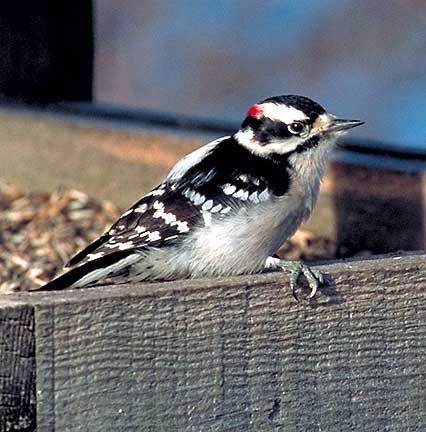Woodpecker - Downy
Scientific Name: Picoides pubescens
Wed, 2nd July, 2025 - 6:50 pm GMT
Sponsor Ads:

Alternative Name
Scientific Name: Picoides pubescensBasic Info
The Downy Woodpecker is very short, only about six inches long. Its coloring scheme is unique, a bright black and white. Its back is white, with black wings, nape and rump, the white coloring continuing across its underbelly and outer tail feathers. The Downy Woodpecker's beak is about half the size of its head; this is smaller than many other species of woodpecker. The Downy Woodpecker has a strange arrangement of toes on its feet, two in the front and two in the back, which enable the Downy Woodpecker to easily grip the tree, or whatever its landed on. It also has a stiffer tail than most birds, allowing it to easily prop itself up next to any common feeder.
Health
If you'd like to attract the Downy Woodpecker to your backyardeaving out a feeder packed with sunflowers and peanuts is a great way to keep this bird well fed, and it will most certainly appreciate the company of a fresh birdbath. Breeding and Propagation: Relative Breeding Ease: Average Unlike most other birds, the Downy Woodpecker's breeding season generally begins in winter, although some northern Downy Woodpeckers do wait until springtime to begin. The Downy Woodpecker will then make a roost, usually in a hollow tree that it can easily drum on, and begin to call out to prospective mates with their call. They will either use their bird call or drum on the tree, with the female of the species taking the initiative and going after the males. Once the birds have mated, they'll choose a good nesting site, and start to dig out the nest. This process can take as long as two weeks to complete, and will never be done in any sort of live tree. The female will lay around five eggs, between April and June and incubation lasts around 12 days or so. After hatching, the baby birds will be cared for by both sexes.Habitat
N/ABehavior
The Downy Woodpecker is one of the most common woodpeckers in North America. The Downy woodpecker is a small, shy bird, which you may frequently find in parks, orchards, and backyards. One of this beautiful bird's favorite trees is the Oak. They are often seen on them. Downies feed naturally on insects and their eggs & larvae, which they find in the crevices of tree bark. But you can attract them by hanging a suet basket with a special bird suet cake inside (You can purchase these at your local wild bird supply store) near the trunk of a tree. You can recognize a Downy by it's black-and-white spotted back, red head tip, white breast, and very short beak. It makes a "keek kee-hee-hee-hee-hee" sound that you will hear ringing out through the trees. The Downy Woodpecker loves to tap, and since it nests mostly in hollow trees, this little woodpecker spends most of its time pecking and tapping at hollow wood to test it, making sure its suitable for a nest. Tapping is also an especially good way of getting insects, the favored food of the downy woodpecker! The tapping causes many of these insects to leave their homes, making it easy for this woodpecker to feed.Origin
North AmericaHistory
The Downy Woodpecker is attracted to orchards, parks and open woodlands across much of the United States and Canada.Common Foods
While not the preferred food of the Downy Woodpecker, it will also eat seeds from trees and fruits, as well as the occasional sunflower or peanut from a bird feeder.Sponsor Ads:
Sander's Rumination: Life is a game, the object of which is to discover the object of the game.
Woodpecker - Downy
Coded by: BGID® | ALL RIGHTS RESERVED Copyright © 2000-2025
Disclaimer | Privacy | Report Errors / Contact | Credits
















